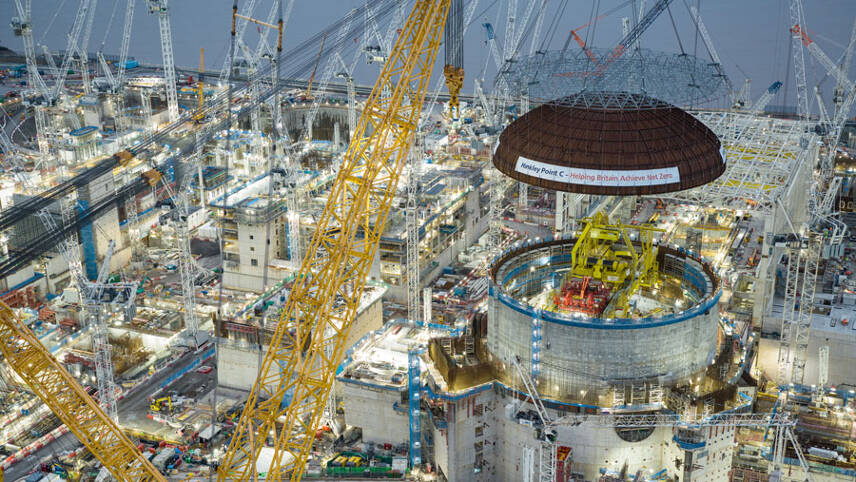Register for free and continue reading
Join our growing army of changemakers and get unlimited access to our premium content

Image: EDF. Pictured: Construction at Hinkley Point C in December 2023
The Civil Nuclear Roadmap from the Department for Energy Security and Net-Zero (DESNZ) forms part of Prime Minister Rishi Sunak’s plans to “achieve net-zero by 2050 in a measured and sustainable way”.
Sunak has, in recent months, thrown his support behind nuclear and fossil fuels while rolling back on low-carbon heating, buildings and transport, as he seeks to politicise decarbonisation options ahead of the general election.
DESNZ stipulates that the UK could host up to 24GW of nuclear generation capacity by mid-century.
This is around four times the current operational capacity; the figure was first floated in an Energy Security Plan last March in support of a target for 25% of the UK’s electricity demands to be met with nuclear generation by 2050.
The roadmap includes a new Government ambition to secure final investment decisions on at least 3GW of nuclear projects every five years between 2030 and 2044. There is a stretching ambition to achieve decisions on up to 7GW within these timeframes.
This builds on existing aims to secure one final investment decision this Parliament for a large project, plus two such decisions in the next Parliament.
Large and small
A first step to achieving the new target is the Government-led exploration of a further GW-scale power plant in addition to Sizewell C – a project which Whitehall is already supporting with more than £1bn.
Timelines and processes for this major plant will be set out by the end of this Parliament. A variety of potential sites are mapped in the roadmap including Bradwell, Hartlepool and Moorside.
These types of projects are typically very costly and take years to develop. Sizewell C has a price tag of more than £20bn and was first consulted upon in 2012.
To that end, SMRs will also have a key role to play in the delivery of the new 2030-2044 plan. The Government last year launched Great British Nuclear, a new industry convening body, selecting an SMR funding competition as its first workstream.
DESNA is aiming for the UK’s first SMR projects to receive a final investment decision by 2029 and to begin operating in the mid-2030s.
The Nuclear Industry Association’s chief executive Tom Greatrex said this twin-track approach is “pragmatic”, providing “greater clarity and predictability” to investors.
Across both SMRs and large-scale projects, the roadmap will detail a further £10m for skills funding to help grow the nation’s nuclear workforce.
Greatrex said that following the roadmap up with action on the ground “with pace and focus” is now necessary.
“To that end, we keenly await GBN’s announcement on the successful winners of the SMR competition and the swift launch of the UK Green Taxonomy consultation,” he elaborated.
The UK was due to publish a Green Taxonomy for finance last year but opted for a delay to flesh out the design of the scheme, which will set out which investments can be classed as ‘green’. Under the EU’s Taxonomy, nuclear meets this classification.
Industry reaction
Union GMB’s national secretary Andy Prendergast reiterated Greatrex’s call for urgency of implementation. He said: “Decades of dithering and failure have left our country’s nuclear capacity in tatters – all but one nuclear power station is due to be switched off by 2030.
“This means the UK is hugely dependent on oil and gas imports from overseas, with all the dangers that entails. Today’s announcement offers some hope, but this roadmap must become a reality – and quickly – or we risk yet another energy false dawn.”
The Energy and Climate Intelligence Unit cautioned that the changes are unlikely to bring significant carbon or cost savings in the near term. Analyst Jess Ralston said: “The Government investing millions of pounds of public money in nuclear should hopefully unleash further private sector investment and experts generally agree that we’ll need some new nuclear in the years ahead. The challenge is the industry has a track record of running over budget and behind schedule, so this does little to boost the UK’s energy security any time soon.
“More offshore wind and insulating homes would help cut the UK’s ties with volatile gas prices, but the Government fumbled the last offshore wind auction and has driven down the number of homes its helping to insulate in the past couple of years.”
Fuelling up
The launch of the roadmap follows on from the UK’s commitment, made earlier this week, to up to £300m for the production of advanced nuclear fuels.
High-assay low-enriched uranium (HALEU), is currently only commercially produced in Russia. No other nation has a Government-backed HALEU investment programme.
DESNZ’s intention is to scale HALEU production in North West England, with a first plant set to enter operations in the early 2030s. The Department has stated that producing the fuel directly will not add to consumer costs,
Energy Security and Net-Zero Secretary Claire Coutinho said: ”We stood up to Putin on oil and gas and financial markets, we won’t let him hold us to ransom on nuclear fuel. Britain gave the world its first operational nuclear power plant, and now we will be the first nation in Europe outside of Russia to produce advanced nuclear fuel.”


Please login or Register to leave a comment.